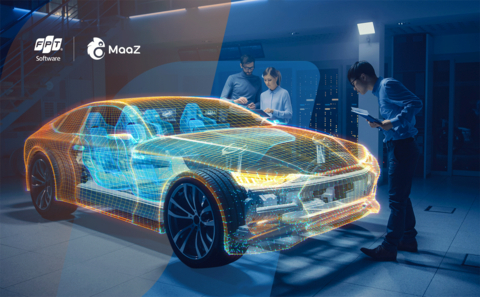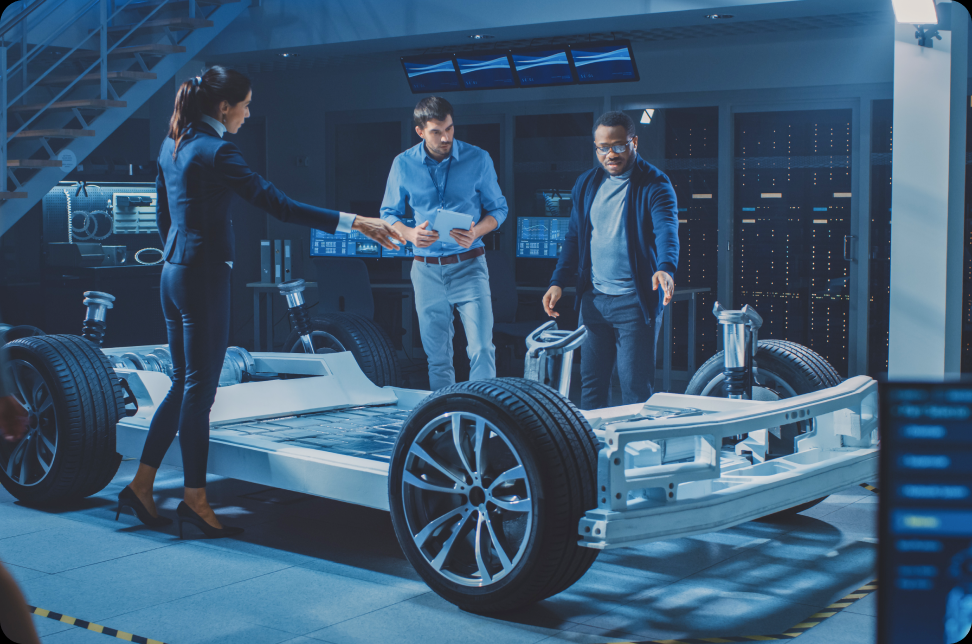From IoT to IoV (Internet of Vehicles): Everything You Need to Know
08-09-2022

<p style="outline: none; margin-right: 0px; margin-bottom: 10px; margin-left: 0px; text-size-adjust: 100%; font-family: BROmega, sans-serif; font-size: 14px;"><font color="#ffffff">As self-driving cars tend to become more of a conceptual reality rather than an idea, the question of how they’ll interact with other vehicles becomes more and more pressing. As such, we can see a new concept taking shape: the Internet of Vehicles (IoV).</font></p><p style="outline: none; margin-right: 0px; margin-bottom: 10px; margin-left: 0px; text-size-adjust: 100%; font-family: BROmega, sans-serif; font-size: 14px;"><font color="#ffffff">Comprising a system that intends to enable vehicle-to-vehicle communications, as well as further insights into human-driven connected cars on the road, the IoV is bound to impact the overall <a href="https://www.fpt-software.com/industries/automotive/" style="outline: none; text-size-adjust: 100%;">automotive development</a>.</font></p><p style="outline: none; margin-right: 0px; margin-bottom: 10px; margin-left: 0px; text-size-adjust: 100%; font-family: BROmega, sans-serif; font-size: 14px;"><font color="#ffffff">Hence, we’d like to dive deeper and identify some of the potential technologies and the impact that they are most likely to have on the matter.</font></p><h2 style="outline: none; font-family: BROmega, sans-serif; line-height: 1.1; margin-top: 20px; margin-bottom: 10px; font-size: 30px; text-size-adjust: 100%;"><font color="#ffffff">Communications</font></h2><p style="outline: none; margin-right: 0px; margin-bottom: 10px; margin-left: 0px; text-size-adjust: 100%; font-family: BROmega, sans-serif; font-size: 14px;"><font color="#ffffff">First things first, having different vehicles communicating with each other, as well as with their surroundings is critical for safety.</font></p><p style="outline: none; margin-right: 0px; margin-bottom: 10px; margin-left: 0px; text-size-adjust: 100%; font-family: BROmega, sans-serif; font-size: 14px;"><font color="#ffffff">Fortunately, <a href="https://www.fpt-software.com/industries/automotive/" style="outline: none; text-size-adjust: 100%;">automotive development solutions</a> have long been in the making and it’s probably to expect two particular interactions to be in the core of the work.</font></p><ul style="outline: none; margin-bottom: 10px; text-size-adjust: 100%; font-family: BROmega, sans-serif; font-size: 14px;"><li style="outline: none; text-size-adjust: 100%;"><font color="#ffffff">Road-to-Vehicle Communications</font></li></ul><p style="outline: none; margin-right: 0px; margin-bottom: 10px; margin-left: 0px; text-size-adjust: 100%; font-family: BROmega, sans-serif; font-size: 14px;"><font color="#ffffff">It’s entirely reasonable to expect that driverless cars will become more reliant on indestructible road sensors which are embedded in the road itself. They’d be turned on throughout the construction, maintenance or even in emergency scenarios, causing each vehicle to reduce its speed or even halt it if there’s danger ahead.</font></p><p style="outline: none; margin-right: 0px; margin-bottom: 10px; margin-left: 0px; text-size-adjust: 100%; font-family: BROmega, sans-serif; font-size: 14px;"><font color="#ffffff"><img loading="lazy" class="alignnone wp-image-114291 size-full" src="https://www.fpt-software.com/wp-content/uploads/sites/2/2019/09/image-article-2.jpg" alt="image-article-2" width="1350" height="900" srcset="https://www.fpt-software.com/wp-content/uploads/sites/2/2019/09/image-article-2.jpg 1350w, https://www.fpt-software.com/wp-content/uploads/sites/2/2019/09/image-article-2-300x200.jpg 300w, https://www.fpt-software.com/wp-content/uploads/sites/2/2019/09/image-article-2-768x512.jpg 768w, https://www.fpt-software.com/wp-content/uploads/sites/2/2019/09/image-article-2-1024x683.jpg 1024w, https://www.fpt-software.com/wp-content/uploads/sites/2/2019/09/image-article-2-600x400.jpg 600w" sizes="(max-width: 1350px) 100vw, 1350px" style="outline: none; border: 0px; text-size-adjust: 100%; max-width: 100%; height: auto;"></font></p><p style="outline: none; margin-right: 0px; margin-bottom: 10px; margin-left: 0px; text-size-adjust: 100%; font-family: BROmega, sans-serif; font-size: 14px;"><font color="#ffffff">More importantly, these communicative infrastructures are probably going to include parking information, weather reports, traffic signal control systems, and so forth.</font></p><ul style="outline: none; margin-bottom: 10px; text-size-adjust: 100%; font-family: BROmega, sans-serif; font-size: 14px;"><li style="outline: none; text-size-adjust: 100%;"><font color="#ffffff">Vehicle-to-Vehicle Communications</font></li></ul><p style="outline: none; margin-right: 0px; margin-bottom: 10px; margin-left: 0px; text-size-adjust: 100%; font-family: BROmega, sans-serif; font-size: 14px;"><font color="#ffffff">With the advent of the Internet and, respectively, the Internet of Things, we can expect proper and real-time communication with our cars. This could easily be the difference between life and death in certain situations.</font></p><p style="outline: none; margin-right: 0px; margin-bottom: 10px; margin-left: 0px; text-size-adjust: 100%; font-family: BROmega, sans-serif; font-size: 14px;"><font color="#ffffff">For example, in the event of an accident, IoV-powered technology could automatically send the information to emergency services, saving precious time which could easily prevent fatalities.</font></p><h2 style="outline: none; font-family: BROmega, sans-serif; line-height: 1.1; margin-top: 20px; margin-bottom: 10px; font-size: 30px; text-size-adjust: 100%;"><font color="#ffffff">Computing Power</font></h2><p style="outline: none; margin-right: 0px; margin-bottom: 10px; margin-left: 0px; text-size-adjust: 100%; font-family: BROmega, sans-serif; font-size: 14px;"><font color="#ffffff">The number of sensors and computers already put in place in vehicles could come as a bit of a shock to the regular consumer. It’s not unprecedented for modern vehicles to boast a complex network consisting of upwards of 100 independent computers or electronic control units (ECUs).</font></p><p style="outline: none; margin-right: 0px; margin-bottom: 10px; margin-left: 0px; text-size-adjust: 100%; font-family: BROmega, sans-serif; font-size: 14px;"><font color="#ffffff">These ECUs rely on heavy lines of codes which is especially true for luxury vehicles. When these vehicles become outfitted for full self-driving capability, these numbers are likely to increase.</font></p><p style="outline: none; margin-right: 0px; margin-bottom: 10px; margin-left: 0px; text-size-adjust: 100%; font-family: BROmega, sans-serif; font-size: 14px;"><font color="#ffffff">Hence, the necessity for elevated computing power will present itself, posing challenges that <a href="https://www.fpt-software.com/industries/automotive/" style="outline: none; text-size-adjust: 100%;">automotive developers</a> are already facing.</font></p><p style="outline: none; margin-right: 0px; margin-bottom: 10px; margin-left: 0px; text-size-adjust: 100%; font-family: BROmega, sans-serif; font-size: 14px;"><font color="#ffffff"><img loading="lazy" class="alignnone wp-image-114293 size-full" src="https://www.fpt-software.com/wp-content/uploads/sites/2/2019/09/driving-car.jpg" alt="driving-car" width="3264" height="2177" srcset="https://www.fpt-software.com/wp-content/uploads/sites/2/2019/09/driving-car.jpg 3264w, https://www.fpt-software.com/wp-content/uploads/sites/2/2019/09/driving-car-300x200.jpg 300w, https://www.fpt-software.com/wp-content/uploads/sites/2/2019/09/driving-car-768x512.jpg 768w, https://www.fpt-software.com/wp-content/uploads/sites/2/2019/09/driving-car-1024x683.jpg 1024w, https://www.fpt-software.com/wp-content/uploads/sites/2/2019/09/driving-car-600x400.jpg 600w" sizes="(max-width: 3264px) 100vw, 3264px" style="outline: none; border: 0px; text-size-adjust: 100%; max-width: 100%; height: auto;"></font></p><h2 style="outline: none; font-family: BROmega, sans-serif; line-height: 1.1; margin-top: 20px; margin-bottom: 10px; font-size: 30px; text-size-adjust: 100%;"><font color="#ffffff">Potential Benefits</font></h2><p style="outline: none; margin-right: 0px; margin-bottom: 10px; margin-left: 0px; text-size-adjust: 100%; font-family: BROmega, sans-serif; font-size: 14px;"><font color="#ffffff">Internet of Vehicle-based technologies could introduce a variety of benefits, including but not limited to the average hours the commuters spend behind the wheel, reducing collisions, and so forth.</font></p><p style="outline: none; margin-right: 0px; margin-bottom: 10px; margin-left: 0px; text-size-adjust: 100%; font-family: BROmega, sans-serif; font-size: 14px;"><font color="#ffffff">But instead of being single-worded, it’s perhaps better to provide particularity with an existing platform. FPT’s aka minds’ IoV platform, for instance, consists of an IoV gateway and a Digital Automotive Intelligent Platform (DAIP) for automobiles to easily connect to the Internet.</font></p><p style="outline: none; margin-right: 0px; margin-bottom: 10px; margin-left: 0px; text-size-adjust: 100%; font-family: BROmega, sans-serif; font-size: 14px;"><font color="#ffffff">DAIP provides all of the common solutions for a broad range of vehicles. These include:</font></p><ul style="outline: none; margin-bottom: 10px; text-size-adjust: 100%; font-family: BROmega, sans-serif; font-size: 14px;"><li style="outline: none; text-size-adjust: 100%;"><font color="#ffffff">Fleet Management</font></li><li style="outline: none; text-size-adjust: 100%;"><font color="#ffffff">Journey Planning and Optimization</font></li><li style="outline: none; text-size-adjust: 100%;"><font color="#ffffff">Route Suggestion</font></li><li style="outline: none; text-size-adjust: 100%;"><font color="#ffffff">Live Monitoring</font></li><li style="outline: none; text-size-adjust: 100%;"><font color="#ffffff">User/Vehicle/Device Management</font></li></ul><p style="outline: none; margin-right: 0px; margin-bottom: 10px; margin-left: 0px; text-size-adjust: 100%; font-family: BROmega, sans-serif; font-size: 14px;"><font color="#ffffff">In any case, while deriving its main concepts from the Internet of Things, the Internet of Vehicles particulates them and specifies them within a certain field – the automotive industry.</font></p>








